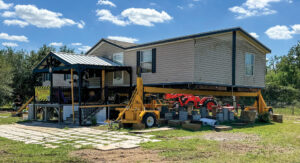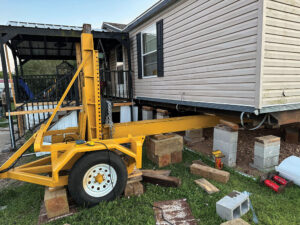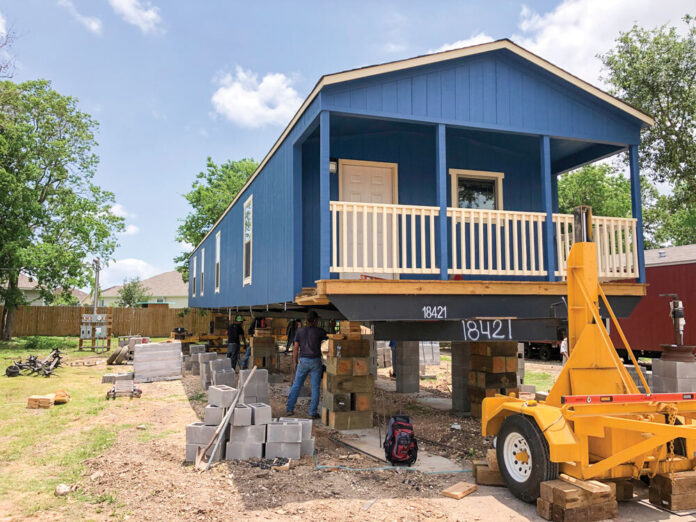When Gerard Hungerford of Texas-based GH Lifts took charge of moving manufactured homes into a community in Dickerson, Texas, the challenge of meeting city-mandated base flood elevation quickly arose. He found that he had to raise some homes as high as 10 feet to meet local compliance requirements.
Then, a new problem emerged: GH Lifts was told they couldn’t use cranes to move the homes into place. They’d have to come up with a new solution for moving the homes while adhering to the heightened base flood elevations.
“It only took me a few minutes from there to think to myself, ‘Huh, I can come up with that,’” Hungerford said.
As a result, GH Lifts has patented an all-new type of mover for manufactured homes. The mover is designed to drastically reduce the footprint required when siting a home in a park while increasing efficiency, speed, and safety.
Phoenix Lift Can Be Quality Replacement for Crane Work
This new mover, dubbed the Phoenix Lift, uses an electric-overhydraulic system to lift the home on a series of I-beams. While the Phoenix Lift secures the home on its I-beams, hydraulics are used to lift the home to the desired height.
“These homes that we’ve been moving with this method average seven, eight feet in elevation,” Hungerford said. “These would take way more time with a crane, taking into account the setup, delivery, and the footprint of the crane itself.”

The Phoenix Lift, which GH Lifts worked on with Alabama-based Trans Lift, enables Hungerford and his team to move two single-section manufactured homes in one day, far faster than previous methods. The Phoenix Lift is added onto a Trans Lift unit to achieve this. Hungerford’s engineering and transportation history led to the design of the Phoenix Lift, while Andy Hill of Trans Lift handles new sales of the mover.
“The biggest positive of using this lift is the time saved versus, say, bringing in a crane,” Hill said. “This house lifting system is very precise, and very safe.”
Lift Put to the Test

According to Hungerford, setting a home into place using this method can take mere minutes, compared to hours using a jack-lift.
The two pillars of this new innovation that Hungerford and Hill both emphasize above all else are precision and safety.
Hungerford first tested the Phoenix Lift on his ranch in Texas with a fully furnished multi-section home. He said the home was sited with enough precision so that not even the front porch had to be re-adjusted.
The increased safety of using the Phoenix Lift over a crane or jack-lift is significant as well. By keeping workers from being under a home that’s several feet above the ground, movers can more easily do their job, often at a faster pace that doesn’t compromise workplace safety.
Implementing a new mover like this one into communities keeps community operators from having to wait on orders for home transport equipment and avoids empty lots due to restrictive zoning laws that keep cranes from being able to move homes in some areas, Hungerford said.
“It keeps them from having an empty lot with no income,” he said. “It’s a win for everybody.”
Though the Phoenix Lift is a relatively new invention, both Hungerford and Hill have high hopes for the future. After showing off the lift for the first time at the Biloxi Manufactured Housing Show & Expo in March, moving pros are already asking for live demos. Hungerford is even going to Florida himself to deliver and test the Phoenix Lift for a new customer.
New modifications to the system, such as add-ons that can further increase the height, speed, efficiency, and safety of the home moving process, are in the works. Yet with how much promise the Phoenix Lift shows in its current form, Hungerford and Hill are ecstatic for what this means for home movers.
“I really believe in this product,” Hill said. “I believe it’s going to be the industry standard for lifting houses.”










